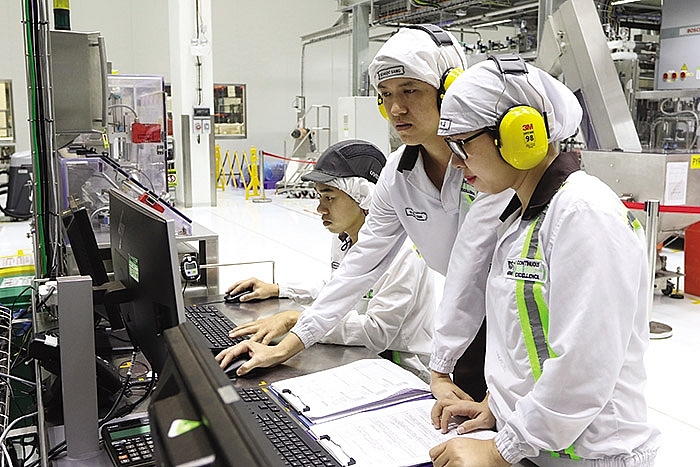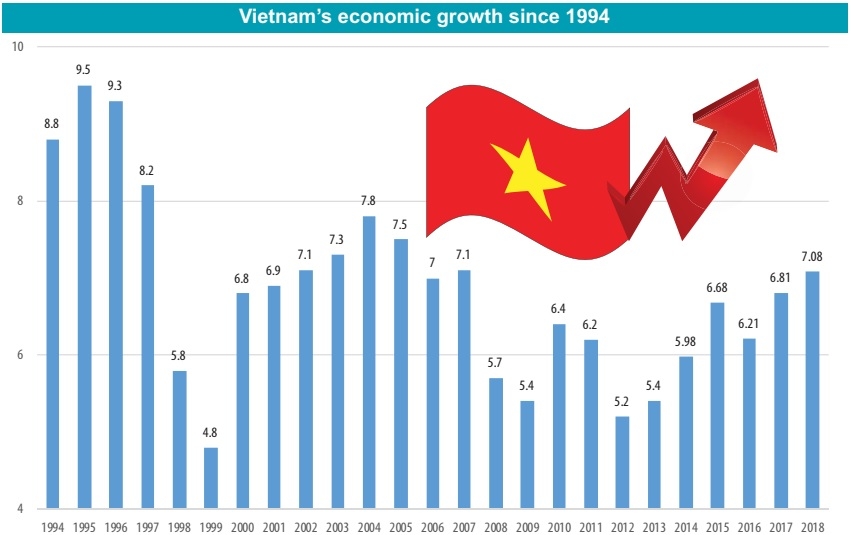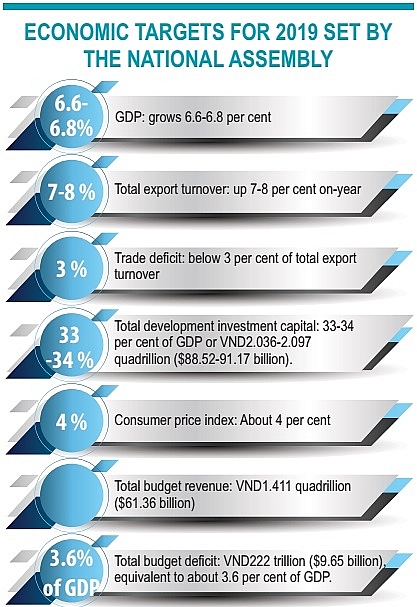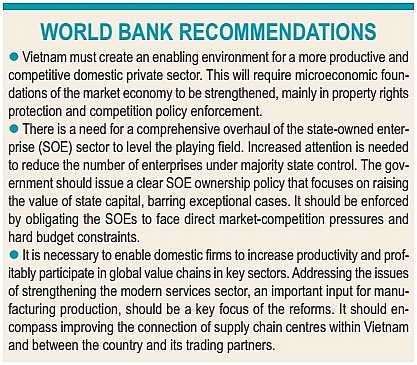2019’s promising economic outlook
 |
Late last week at a conference on Vietnam’s socio-economic development for 2018, Party General Secretary, State President Nguyen Phu Trong announced that the economy has reaped “extremely significant achievements on economic growth and growth quality for 2018. GDP has hit more than $245 billion.”
“Weathering difficulties, we have successfully accomplished all 12 socio-economic goals,” he continued. “Especially, we have reached a very impressive growth rate, at an estimated 7.08 per cent, the highest level since 2008. Growth quality has significantly improved in almost all indexes,” he told leaders of the Party and the government.
This rate is higher than the target of 6.7 per cent earlier set by the National Assembly, and recent forecasts by high-profile international organisations, such as the Standard Chartered (7 per cent), the World Bank (6.8 per cent), the Asian Development Bank (6.9 per cent), Fitch Solutions (7 per cent), and the Union Bank of Switzerland (6.6 per cent).
The growth rate for 2018 has affirmed the timeliness and effectiveness of solutions enacted by the government. It also reflected great efforts by all the party, the state, ministries, agencies, localities, people, and enterprises.
 |
Improvement in growth quality
“Though the growth rate is quite high, the economy’s credit growth has climbed just below 14 per cent, lower than the 17-18 per cent seen in previous years. This has reflected that the economy has grown sharply in quality,” stated Prime Minister Nguyen Xuan Phuc. “Previously we were extremely anxious about a collapse in the national fiscal picture, but now we have a revenue excess worth $3.5 billion from the initial estimates, with a record in foreign-exchange reserves.”
 |
According to the Ministry of Planning and Investment (MPI), since the new government was elected in early 2016 the contribution of the total-factor productivity (TFP) is on the rise.
Specifically, the TFP ratio in the economy sat at 33.58 per cent in the 2011-2015 period, but rose to 43.29 per cent between 2016 and 2018. In 2018, the ratio stood at 43.5 per cent. TFP is a measure of the efficiency of all inputs to the production process. Increases in TFP result usually from technological innovations or improvements.
Meanwhile, the economy’s labour productivity has also climbed 5.93 per cent from $4,166 per labourer in 2017 to $4,512 in 2018. In 2016, the figure was $3,852 per labourer.
Per capita GDP is estimated to be $2,587 for 2018, up $198 against 2017.
Alongside this, the economy’s incremental capital output ratio (ICOR), which is the additional capital required to increase one unit of output, reduced from 6.42 in 2016 to 6.11 in 2017, and 5.97 per cent in 2018. The average ICOR for the 2016-2018 period is 6.17 per cent, lower than the 6.25 of the 2011-2015 period.
Private sector investment, which plays a crucial role in economic growth, is also on the rise. Specifically, this type of funding is estimated to occupy 42.4 per cent of total economy investment in 2018, higher than the 40.6 per cent last year and 38.9 per cent in 2016, and the average of 38.3 per cent in the 2011-2015 period.
“All sectors in the economy have been developing comprehensively in 2018, creating great momentum for higher growth,” PM Phuc said. “Specifically, the agro-forestry-fishery sector grew to a high level of 3.76 per cent, the industrial and construction sector 8.85 per cent, and the service sector 7.03 per cent. Total revenue of retail and service consumption is also projected to climb 11.7 per cent for 2018.”
The processing and manufacturing sector, which contributes 80 per cent of the economy’s industrial growth, continued its strong uptrend, at 11.9 per cent in 2016, 14.5 in 2017, and 13 per cent in 2018.
“All of these improvements, which follow the government’s sound investment and business policies, have also been seen with growing confidence of businesses and investors,” said Minister of Planning and Investment Nguyen Chi Dung.
According to the General Statistics Office’s latest survey on manufacturing and processing businesses in Vietnam in the fourth quarter of 2018, 47.3 per cent of respondents expected their performance will get better in the first quarter of 2019, against the fourth quarter of 2018. Some 88.3 per cent of foreign companies believed their performance in the first quarter of 2019 will be better than in the previous quarter. The respective rates at Vietnam’s state-owned enterprises and privately-owned enterprises are 83.2 and 84 per cent.
It is estimated that a record number of nearly 131,300 enterprises have been newly established in 2018, with total registered capital of VND1.478 quadrillion ($64.26 billion), up 3.5 per cent in the number of enterprises, and 14.1 per cent in capital, against the previous year.
Outlook for 2019
 |
Party General Secretary, State President Nguyen Phu Trong stressed that in 2019, great efforts must be made to hit a growth rate higher than the 7.08 per cent of 2018. “This will be a heavy task, and all of us must do our utmost to realise this target,” he said. “We should not rest on our laurels and be oversatisfied with what we have achieved. We must make bigger efforts to reap bigger achievements.”
At a meeting with his economic consultancy group early last week, PM Phuc said that he wants the economy to grow at least 7 per cent for 2019, with the macroeconomy being maintained, higher than the target of 6.6-6.8 set earlier.
The group said that the country has great potential and new opportunities to reach this goal and even higher in the following years. They proposed three growth scenarios for the 2018-2020 period, based on standard economic conditions.
Under the first and second scenario, the average annual growth rate will be 6.86 and 6.91 per cent, respectively. The third scenario, the most optimistic, is expected to see the rate at 7.06 per cent. In 2019, the inflation is forecast by the group at below 4 per cent, slightly higher than the on-year 3.54 per cent rise of 2018.
“To reach our growth target for 2019, among many solutions, we will especially focus on the development of the private sector, with more policies and mechanisms in favour of it,” PM Phuc said. “I have worked with the Central Economic Commission about plans to examine some ministries and localities about private sector development, especially key localities, to further foster the sector, which is an important propellant for the economy.”
“Vietnam’s growth model in the coming years will depend much more on a rise in labour productivity and developing a digital economy,” he continued.
“We boost Industry 4.0 as it offers us great potential to increase labour productivity. We will not only enhance the country’s existing natural resources, but more importantly, enhance the aspiration and brainpower of over 100 million Vietnamese at home and abroad.”
The World Bank has also made several suggestions for the country to grow further in the near future, in order to improve the economy’s productivity (see box).
What the stars mean:
★ Poor ★ ★ Promising ★★★ Good ★★★★ Very good ★★★★★ Exceptional
 Tag:
Tag:
Related Contents
Latest News
More News
- Businesses ramp up production as year-end orders surge (December 30, 2025 | 10:05)
- Vietjet chairwoman awarded Labour Hero title (December 29, 2025 | 13:06)
- How to unlock ESG value through green innovation (December 29, 2025 | 10:03)
- AI reshapes media and advertising industry (December 29, 2025 | 08:33)
- FPT and GELEX sign deal to develop blockchain tech for global markets (December 29, 2025 | 08:29)
- Vietnam’s GDP forecast to grow by 9 per cent in 2026 (December 29, 2025 | 08:29)
- Women entrepreneurs are key to Vietnam’s economic growth (December 29, 2025 | 08:00)
- Vietnam's top 500 value-creating enterprises announced (December 27, 2025 | 08:00)
- The PAN Group shaping a better future with ESG strategy (December 26, 2025 | 09:00)
- Masan Consumer officially lists on HSX, marking the next phase of value creation (December 25, 2025 | 13:20)























 Mobile Version
Mobile Version